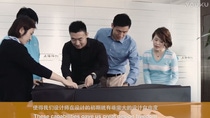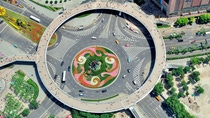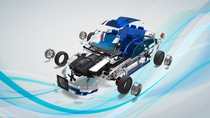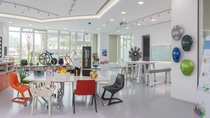Design freedom: next stop of innovation
Today’s auto manufacturers regard car design as an important topic for research and development. For consumers, apart from vehicle performance, their perceived values, depending on the design and material properties, are becoming increasingly important. They will bring more ideas on car design and more space for innovative technology.
At the CHINAPLAS 2017 “Design x Innovation” event in May 2017, an automotive instrument panel prototype co-developed by BASF and Yanfeng impressed visitors.
Made with Haptex®, an innovative polyurethane (PU) solution for synthetic leather from BASF, the surface of the instrument panel features distinctive texture, special color and excellent haptics. Without the use of organic solvents, the product complies with the stringent volatile organic compounds (VOC) standards in cars.
Yanfeng is one of the most important automotive component suppliers in the world. It provides products and services in automotive interior, exterior, seating, electronics and safety systems. Just like any other automotive interior designer, the Yanfeng designers face more restrictions than artists and fashion designers. Taking aesthetics into account, they have to pay extra attention to certain realistic issues – material properties such as water and stain resistance, feasibility in manufacturing and consistency in quality. Considering the high requirement in manufacturing and strict criteria on testing, many options are excluded from the material list. Automotive interior designers previously looked for corresponding materials and designs based on customers’ needs. In doing so, the limited choice in materials may lead to a convergence in design and brilliant design may be difficult to open up.
As the penetration of vehicles rises in China, consumers are becoming more demanding in both appearance and performance when they make a purchase decision, thus posing greater challenges for designers. For years, Yanfeng has been thinking about how to make breakthroughs in interior design through product innovation.
At BASF, there has already been solutions to address Yanfeng’s concern. As a leading chemical supplier in the automotive industry, BASF offers the broadest portfolio in advanced materials and relevant solutions to the auto industry. It helps designers to understand material features, to inspire them to break the existing design limitations and to achieve greater design freedom while meeting the multiple engineering requirements of lightweight, high fuel efficiency, low VOC, among others. Since the early 1980s, BASF and Yanfeng have established a long-term cooperation with mutual trust. The two sides listen to each other’s needs and carry out exploration on the application of advanced materials.
“Cooperation among brand owners, designers and material suppliers is essential because driving innovation is a multifaceted endeavor, from material selection to production and commercialization.” said Andy Postlethwaite, Senior Vice President, Performance Materials Asia Pacific, BASF.
When the material experts from BASF introduced Haptex to Kate Zhong, Senior Color and Trim Designer of Yanfeng, the new synthetic leather instantly attracted her interest. After a discreet study of Haptex, she found that it had many excellent features that were able to address market pain points and meet the potential demands of consumers.
For instance, the auto industry is paying more attention to the environmental performance of interior leather materials. Adhesives and chemical solvents, more or less applied during the conventional processing of genuine leather or artificial leather materials, brings odour or VOC into cars. However, Haptex is produced with no organic solvents. BASF has also eliminated the conventional wet process step and the use of adhesives in the dry process step. The synthetic leather, therefore, enables vehicles to meet stringent VOC standards in China and helps to make car indoor air healthier. In view of the increasingly strict environmental protection standards for vehicles, the feature becomes a highlight that appeals to designers.
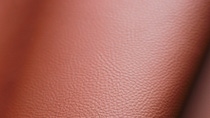
In addition, when stretched, Haptex can maintain its texture unchanged, without any defect of color loss. As a result, the desired color and texture in design can be achieved during the actual manufacturing, where the consistency of material quality can also be ensured. Meanwhile, the performance of sewing is also optimized to prevent stitches from being broken, so as to perfectly present the effects expected by designers.
Furthermore, Haptex, as a decorative material, features the soft haptics as real leather but has a more outstanding look compared with traditional leather or plastics. It meets the demands of car owners for superior interior decoration while offering designers a higher degree of design freedom. “Haptex provides more diversified textures and colors to choose, which means more possibilities for designers,” said Yanfeng’s Zhong. For consumers, of course, this also indicates more or even customized car interior options.
In its discussion with BASF, Yanfeng applied Haptex in the automotive instrument panels – the best display scenario for interiors and an important indicator of future design trends. It successfully debuted at the CHINAPLAS 2017 after four months of design, development and production. In future, BASF and Yanfeng will also cooperate to promote the commercialization of this design.
Yiwen Zha, IP & Operation Director, Yanfeng, calls design the essence behind a brand. Design, meanwhile, can accentuate the uniqueness of the material giving it meaning to its benefits. “Through the deep interaction among brand owners, designers and material suppliers, it brings out the material uniqueness from materials to product design, development and the finished end products,” said Zha. “The true meaning of such cooperation is to provide the best driving experience for consumers. In future, we will work together to explore more possibilities of innovative materials applied in auto components and meet the aesthetic and quality needs of the new-generation consumers.”
As a leading supplier in advanced materials, BASF values the crossover and integration of art and technology with which to assist designers in creation.
The designers of BASF’s Coatings division in China, Japan, the United States and Germany conduct extensive research and in-depth analysis every year. They uncover global trends and cultural shifts that will influence vehicle color choices three to five years from now, and issue global and local trend reports and color forecasts. Based on the report, the application team develops specific colors for customers.
As a cross-disciplinary hub, the BASF Design Centre Asia Pacific, founded in 2016, is to embrace industrial designers from China and the Asia-Pacific region. It provides consultation service, R&D support and simulation and testing devices for them to narrow the distance between the material and design industries. Currently, BASF is cooperating with several auto manufacturers on car interior design, vehicle structure development and vehicle color under the Design Center.
For a long time, BASF has been fostering creative ideas among young designers through various car design competitions. In 2012, the company organized the first global design competition for car seats – ‘Sit Down. Move.’ – calling for car seat designs with emphasis on aspects such as comfort, ergonomics, safety and weight. In January, 2017, BASF sponsored the new "Innovative Use of Materials Award" at the Car Design Awards China 2017 to challenge young designers to tap into its portfolio of advanced materials to address global automotive trends. These included the desire for increasing design freedom, lightweighting, emissions reduction, heat management and fuel efficiency.
“Design is shifting China into a main force of originality worldwide, and also an innovation-driven society,” said Postlethwaite. “With our innovative materials, integrated design and R&D capability, BASF will continue to support excellent designs so as to meet consumers’ demands, as well as the latest regulations and standards.”
Advanced materials have already opened the gate for the future design freedom of cars. All will start right from here.
